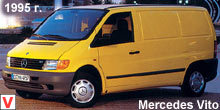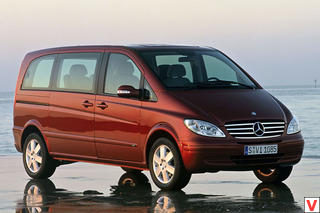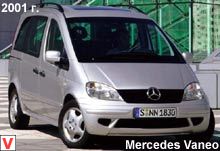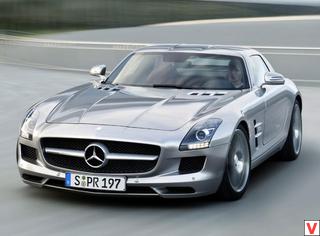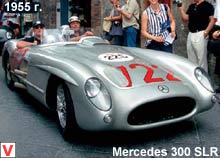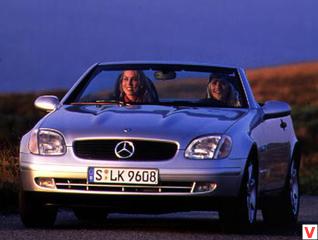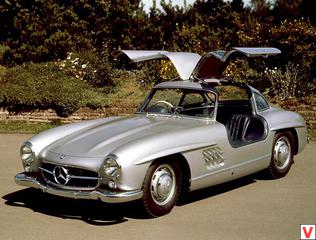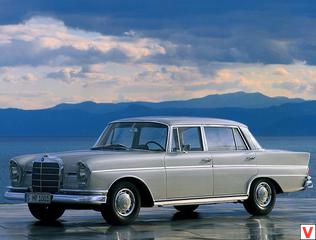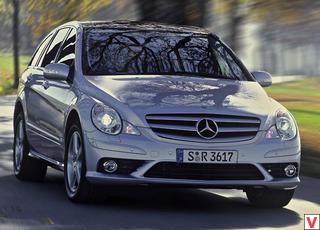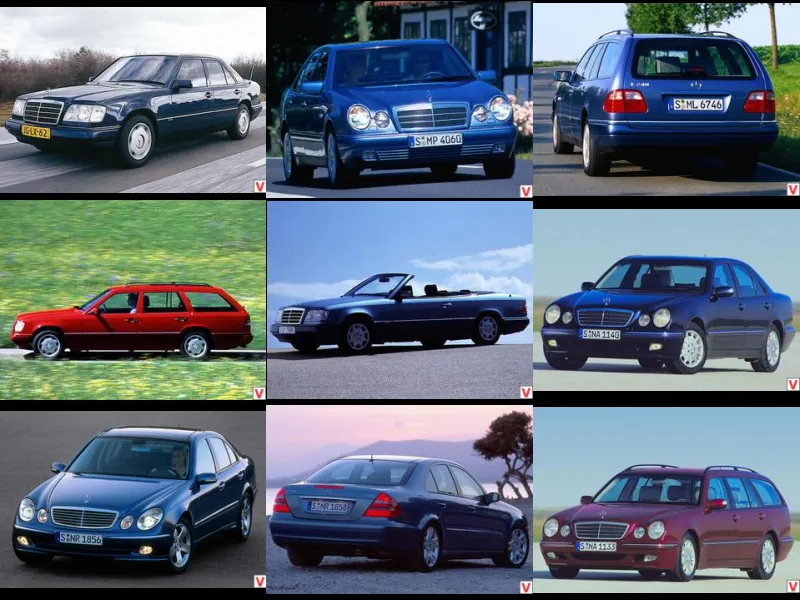
The history of this popular model, which has always combined comfort, reliability and a high degree of safety, is very extensive. The first car of this series (model 170) was created in 1947 and marked the beginning of the post-war production. Then in 1953, followed by the models 180 and 190, better known as the “Ponton Mercedes”. Over the next 9 years, more than 468 thousand cars of this range were sold, including diesel ones. Production of the W110 series began in 1961, and until February 1968, more than 628 thousand cars were produced. This successful series was replaced by no less successful W114 / 115.
In 1968, the first time saw the light sedan with an extended wheelbase, as well as a coupe version. In 1976, the W123 car series followed. In addition, a versatile version appeared. And finally, the debut of the W124 series, which took place in November 1984. From the copies of the present E-class, made not earlier than the end of the 93rd, the models of the W124 series of early years can be distinguished by a deep niche for the rear license plate and narrow black side moldings. Of particular interest is the "one-armed priplyasyvayuschy" janitor.
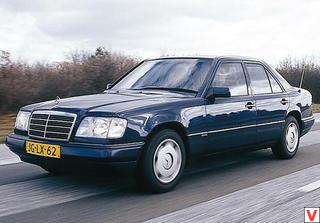
" The W124 introduced a differential with automatic locking (ASD), an anti-skid system (ASR) and, for the first time in a production passenger car, all-wheel drive with automatic torque distribution (4Matic). In September 1988, W124 customers were offered an airbag as an additional equipment ... .. Four years later, both the airbag and ABS were included in the basic equipment of all Mercedes models. Sufficiently conservative (in a good way) and convenient to use, reliable, with durable engines and a spacious interior, coupled with a beautifully crafted interior and ergonomics, the Mercedes-Benz W124 is almost a reference passenger car of the 1980s.
Seven interior options with tapestry or leather seat trim were envisaged. A huge supply of driver's seat adjustment, remotely retractable rear head restraints, comfortable seat belts, tightness and excellent body insulation - for those who value above all the comfort and safety of the ride. The only drawback of the huge 520-liter luggage compartment - the inability to place long loads inside the cabin - is compensated by good lighting, low location of the edge of the trunk and practical pockets for small things and tools. In August 1989, the W124 underwent cosmetic retouching. He received a wide plastic lining on the door and the bottom of the body with chrome molding.
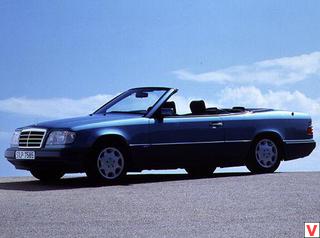
On the bumpers and door handles appeared chrome. Changed glass headlights. There was more space in the cabin, more comfortable seats appeared, and in the decoration more valuable types of wood were used. In the same year, for the first time Mercedes W124 presented the engines with fully electronically controlled power and ignition systems. So, as a result of another modernization of the “W124” model at the end of 1993, the first E-class appeared, which still remains a fairly prestigious car. At that time, the new indexation of all Mercedes-Benz was introduced: instead of 200E, 220E, and so on, the more modern E200, E220, E280 came ...
The letter in front indicates the E-class, and the following numbers - engine capacity. So there was the first E-class, which will be discussed. The first E-class differed almost flat rear wall of the trunk lid (very similar to the "one hundred and fortieth"), so that the deep niche of the license plate gave way to a simple stamping, chrome-plated molding and wide lining on the sidewalls, the grille "recessed" in the hood. When the E-class went on sale, in the warehouses of Mercedes dealers throughout Europe there were a lot of cars of the previous generation, which began to turn into the E-class.
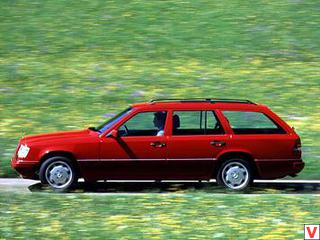
For this it was necessary, by and large, to replace only the hood with a false radiator grille and boot lid. European dealers carried out such an operation only with cars of 92-93 years, in which gasoline engines have already appeared, having four valves per cylinder (technically, these cars do not differ from the E-class). However, in our market one can meet the alleged E-class of the eighties in general! Just, On top of that, instead of old-fashioned side moldings, modern plastic linings are installed on the sidewalls of the body. Such cars give out, first of all, motors with two valves per cylinder.
In the service, you can check the year of manufacture of the machine by downloading its VIN number into the computer. Cars «Mercedes» initially very expensive, but at the same time very strong and durable. E-class exists in several bodies, first of all - it is "sedans", prevailing in the market for used cars. Universals of the E-class (Touring) - the best option for practical people. Having kept all the advantages of a sedan, the station wagon has the advantages - a large useful volume of the passenger compartment, which, with the rear row (middle) folded, reached 2180 liters. In his trunk, you can install an additional 2-seater seat, with which the total number of seats comes to seven.
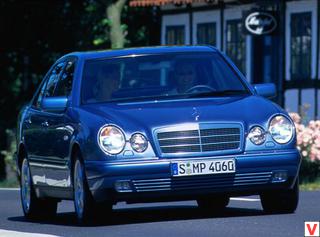
However, the main rear seat can be folded in a 2: 1 ratio. The model has retained a unique rear suspension with automatic booster to maintain the level of the rear of the body above the road. In the Mercedes program, the wagon is designated with the letter “T” after the numbers, for example, “E280T”. Traditionally, the “personal” Mercedes-Benz models with a two-door coupe without a pillar roof are always considered to be the so-called hardtop, which, when the side windows are lowered along the cabin “ventilation”, is comparable to a convertible.
At the same time, such a body is much more practical, and its passive safety is higher. The streamlined body, made on the shortened (by 85 mm) chassis of the sedan, turned out to be very stylish. Coupe was designated by the letter "C". Cabrio cabriolet is based on the coupe.

One of the few cabriolets created on the basis of a business class car. This fully four-seater car (which is rare among modern cars of this type) with an automatically folding top was equipped only with gasoline engines. Mersedes E-class is one of the few cars that are offered with such a wide range of engines - from modest four cylinders to multi-liter V8s ... The M111 series is equipped with two four-cylinder engines - “E200” with a capacity of 136 hp. and "E220" - 150 hp By themselves, these engines are reliable and durable, but they were equipped with various injection systems. Unsuccessful option - the so-called injection PMS. Its control unit is too sensitive to water and salt.
He is afraid of an elementary car wash. Further, the six-cylinder E-class series “M104” - modifications “E280” (193 hp) and “E320” (220 hp) - with typical Mercedes-Benz noiselessness and dynamism even at full load. For this, however, have to pay a solid fuel consumption.
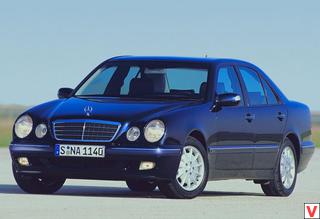
In the city, six-cylinder cars eat about 17 liters / 100 km. Motors of the M104 series are rather durable. With high-speed modern “Mercs”, the powerful “E420” of the M119 series with an eight-cylinder engine can be on an equal footing. The car is equipped with a 4.2-liter V8 capacity of 279 forces. This motor is probably the most reliable, but also quite voracious: with a discreet ride, a twenty-liter canister of not the cheapest gasoline flies every hundred kilometers into the pipe.
In short, the car is addressed to those who really love to drive fast and are able to maintain such a high-speed car. The dream of many collectors - the legendary "E500" - a reliable and incredibly fast sedan. Externally, the “supermers” are distinguished by separate headlights, bumpers of a different shape with regular front “foglights”, widely swollen front and rear wheel arches and a rich salon with sport seats. The rest - the classic and noble "one hundred and twenty fourth." This super-power (326 hp) model with a 5-liter M117 V8 engine from the “five hundredth” S-class reaches 100 km / h in just 6.1 seconds.
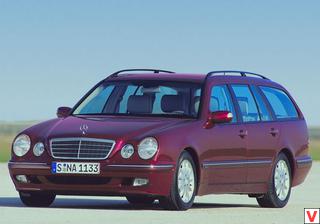
This model was assembled on the Porsche conveyor. For especially hotheads, the E60 AMG version with a 6-liter V8 with a capacity of 381 hp was offered. and overclocking in 5.4 seconds. But there are very few of them even in Germany.
In the tradition of "Mercedes-Benz" both models were supplied only with automatic boxes. Also noteworthy diesel Mercedes E-Class. The E200 Diesel version at one time attracted low-cost buyers. It cost even less than a petrol "E200"! However, the four-cylinder diesel engine is frankly noisy and produces a noticeable vibration. The most popular because of the price / performance ratio was the 5-cylinder diesel. In work, it is much softer and quieter.
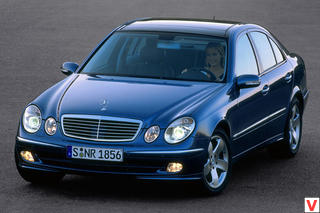
The three-liter straight-line “six” was offered in two versions: atmospheric (136 hp) and turbocharged (147 hp). Cars with such motors are expensive both by themselves and in maintenance. The "six" works practically without the characteristic diesel tarahteniya, extremely gently. Finally, the “EZ00 Diesel” and “EZ00 Turbodiesel” are very fast and dynamic. In 1995, Mercedes-Benz introduced the E-class passenger cars in a new body - the W210 with 4 round headlights. "210th" was a worthy heir to the car series "124", which sold around the world in the amount of 2.7 million.
New design of the front end with separate round headlights (in fact, they are combined into two block-shaped lamps of complex shape) whom leaves indifferent. “Big-eyed Mercedes” inherited the main features of the corporate identity, which was confirmed by the unprecedented growth of European sales of the model in the next three years, such that many of its competitors in the higher market sector (F) had to push back strongly. 210-Series sedans remain the most successful at the top of the middle class. Like its predecessor with the 124th body, the E-Class is a sturdy and reliable car. Impressive smoothness of the car.

Improved wheel suspension almost completely neutralizes the impact of road irregularities. For the first time, rack and pinion steering was used on vehicles of this class. Among the innovations are a rain sensor, an outdoor air pollution sensor, the Parktronic system. A year later, the “adaptive” 5-speed FRG with electronic control appeared, allowing to change the switching algorithm depending on the style of driving. For class E cars, more than 6,400 variants of fulfilling individual wishes regarding design and technical equipment are offered.
Additional equipment and accessories include child seats, a fridge, comfortable seats with ventilation, a dynamic navigation system (DynAPS), a Comand display and control system with an integrated radio tape recorder and a navigation system, etc. Initially, the E-Class had a fairly rich basic equipment, which included electric equipment (window-mirrors), height-adjustable front seats. For security reasons, the car was equipped with a Window-Bag window airbag, which opens during a side impact in the form of a curtain between the front and rear racks; two-stage frontal airbags; inertia seat belts; multifunction steering wheel, ABS, ESP.

All this equipment was available regardless of the version and equipment of the cabin, which provided for three: Classic, Elegance and Avantgarde. The cheapest of them is the Classic, which is distinguished by the lack of leather and minimal use of wood in the interior trim, simple wheels, green tinted glass and "low" center console - without the armrest between the front seats. But even this option is very representative. The trunk of the sedan, despite the large 520-liter volume, is also very convenient. Elegance-style cars look richer thanks to chrome on the outside door handles and bumpers. The salon of this version flaunts a walnut finish.
The steering wheel and lever box are covered with leather, which can be trimmed and seats. Rims - cast, ten-spoke. Instead of the rotating arms of ventilation, air conditioning and the “stove” on the center console, a modern climate control unit with a display and keys is already being used. The most elite performance - Avantgarde.
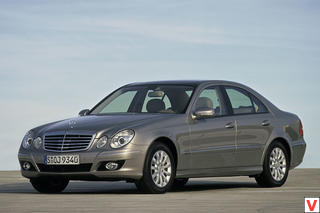
It has, so to speak, a sporting bias. The interior is trimmed with dark, almost black maple and leather. Special wheels and almost obligatory xenon light give respectability to the external appearance. In addition, in the performance of Avantgarde glass tinted not widespread green, but blue.
However, it should be noted that Avantgarde low sports suspension does not in the best way tolerate Russian roads. Since 1997, the “Brake Assist” system has been installed on all E-class cars, which recognizes extreme braking and helps the driver to shorten the braking distance to a minimum. In addition, this system itself monitors faults occurring in the engine, electrics or transmissions and reminds you to change the oil or brake fluid using the Check Engine light bulb on the dashboard. Even in the service book it is indicated that visits to the service stations are made at a frequency of 15.000-22.000 km at the signal of this light bulb.
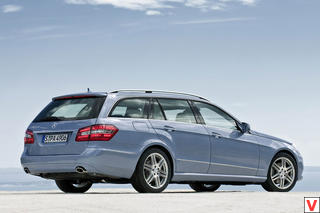
Since 1997, the program appeared all-wheel drive version of the E-Class - "4Matic" (transmission "4x4"). This is a complex transmission, which combined the 5-speed automatic transmission and the traction control system - in the event of skidding, it brakes the spinning wheel, providing better grip. This 4Matic transmission constantly smoothly redistributes the torque between the front and rear axles through the viscous coupling (with normal driving in a ratio of 33:66), and there are no inter-axle and axle differential locks, as they are replaced by the “smart” ETS system, which itself brakes the slip wheel account of the braking system.
For the E-Class, a wide range of engines is presented, which are divided into three groups. The first includes economical gasoline and diesel engines with a working volume of 2.0-2.7 liters and 115-170 hp. Machines with such motors have low fuel consumption and fully satisfy the needs of most E-class owners.
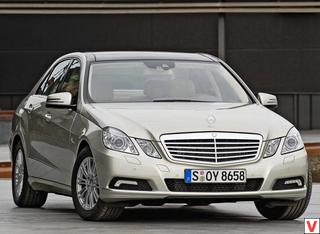
The other group includes more powerful 6-cylinder 2.8-and 3.2-liter engines, which, as a rule, work with automatic 5-speed gearboxes. These engines allow you to more fully reveal the full potential of the design incorporated in the E-class. More modern engines appeared in 1997. These are not in-line, but already V-shaped “sixes” of 2.4, 2.8 and 3.2 liters (170, 204 and 224 forces, respectively). On average, V6 is 25% lighter than the row “sixes” of the previous generation, they are perfectly balanced, and their work is almost not felt on the controls. Yes, and fuel consumption has decreased in comparison with the in-line counterparts - in the city it will be about 13 liters.
The third one includes the most prestigious V-shaped "eights" with a working volume of 4.3 and 5.4 liters. The models equipped by them, perhaps, can be carried to representative. For the powerful “E420” with a 4.2-liter V8 with a capacity of 279 forces, since 1997, the Germans have increased the engine capacity by 100 “cubes”, leaving the power unchanged, in order to increase the already considerable torque. Average fuel consumption is about 20 l / 100 km. The Mercedes tuning studio launched the E50 AMG model in 1996, and a year later, in 1997, the E 55 AMG, the most powerful sports sedan, was introduced in Frankfurt.
The main changes that were introduced into the standard E-class by AMG masters concerned the engine, suspension and car body refinement. So, the E50 AMG received a forced 5-liter V8 with a capacity of 347 forces. With such a potential, the car accelerated to a hundred in 7.2 seconds, and the maximum speed was limited to the standard 250 km / h. The E55 AMG model had an even more impressive 5.4-liter “eight” with a power of 354 power. Therefore, acceleration to a hundred takes only 5.7 seconds, and the mighty torque (530 Nm) literally throws the car forward even from 200 km / h.
Externally, AMG cars are distinguished by plastic door sills, lower bumpers, additional spoilers and special sport wheels. The clearance of the sports E-class is 2.5 cm less compared to the standard model. Chic interior two-tone leather business card creations AMG.
And in 1998, the "big-eyed" began to equip the new generation of diesel engines with a common rail power system (Mercedes with such engines are designated with a CDI index). The previously known E200CDI and E220CDI survived, but received more powerful engines of 115 and 143 hp. From 1995 to 1999 More than 1 million W210 cars were produced, most of which are operated in Europe. No wonder this model has been and remains one of the standards of the business class. In the summer of 1999, the "big-eyed" underwent modernization, over 1800 different changes were made to the design. There are new engines, transmissions, equipment has changed.
The most extensive program of E-class models, by the beginning of 2000 included 27 basic complete sets. The external difference between the “new” cars and the “old ones” is a form of a lower front end with an integrated bumper, the edge of which reaches the middle of the headlights. Such a car is easily recognizable by turning signs implanted into the exterior mirrors, while, like the earlier version of the flasher, are located on the front wings. Among the features of the E-Class wagon is a very spacious luggage compartment, the volume of which with the rear seat folded reaches 1.97 m3. As standard equipment for the Mercedes E-class electronic stability control system ESP is installed.
On all-wheel drive versions of the 4Matic, the traditional differential locking system is no longer used, but the imitation of the locking system by slowing down the towing wheels with the help of the ABS. Since 2000, models are equipped with engines 270 CDI and 320 CDI. The program appeared all-wheel drive E430 4 Matic, the front wheels of which are connected, however, only when the rear wheels slip. The most powerful sports sedan E55 AMG 4 Matic and wagon E55T AMG 4 Matic have a special design and excellent speed qualities. At the end of 2001, the appearance of the E400 CDI model with the latest 4.0-liter turbocharged V8 diesel engine rated at 250 hp.
In November 2001, production of the W210 ceased. Modifications with a station wagon were assembled before the start of 2003. The exact number of cars produced with a body W210-1350128. This is about 24% of the number of passenger Mercedes, released from 1995 to 2001.
A significant event in November 2001 was that the figure of 10 million E-class car sales in their history was reached. In January 2002, the premiere of the new E-Class sedan (body type W211). The car a little more "added" in size, and its appearance has acquired a more rapid appearance - a magnificent sculptural form of glass and steel. The highest level of comfort for both the driver and passengers corresponds to the same level of active and passive safety.
Externally, the car has retained the style of its predecessor: the same separate round headlights in the front, only now they consist of several lamps hidden under one cap. The back of the new E-class is made in the style of the Mercedes S-class executive sedan. The interior of the car is now much more spacious due to the increased wheelbase, as well as a newly designed interior. Informative devices in the form of liquid crystal columns will provide only the most necessary and relevant information, and the sound of the engine running and the noise of city streets will not disturb you due to the almost perfect sound insulation.
Initially, the creators not only provided the E-class cars with a rich bundle, but also equipped them with the most innovative technology. Especially for the E-class, the semi-active air suspension Airmatic Dual Control was developed, with which the model E 500 is serially equipped. It allows the car to “ignore” the irregularities and hover over the road. The brake system Sensotronic Brake Control (SBC) takes care of passenger safety: it automatically dries brake discs on wet roads and, thanks to its advantages, optimizes the functions of the rest of the ESP, ASR, ABS and BAS safety systems. The computer calculates the necessary braking force and purposefully distributes it to the wheels.
In addition to technical delights, optional multi-contour seats are offered with the function of adaptation to the dynamic dynamics of motion multicontour. If necessary, can do a massage of the back and legs. It can be noted eight airbags (two front, four side for the front and rear passengers, two side upper inflatable "curtains"), as well as automatic opening and closing of the trunk. As an option, the equipment will not be installed.new cruise control system and branded entertainment system COMAND. For new items provides a whole range of modern engines.
To begin with, they will offer proven petrol and diesel engines with a working volume of 2.2-5.0 liters in the power range of 150-306 hp. A 177-horsepower 2.4-liter engine and a 3.2-liter engine rated at 224 horsepower. Later, a five-liter V8 with a power of 306 “horses” from the Mercedes S-Class was added to this row.
Diesel engines: 220 CDI with 150 horsepower and 270 CDI, with 177 horsepower. This set was supplemented with a 197-horsepower 320 CDI engine, and from March 2003, with a four-liter V8 with 260 horsepower. All models (except for E320 and E500) are completed with either a 6-speed manual gearbox or an adaptive 5-speed hydromechanical “automatic”. Now the E-class received three new engines at once - a gasoline engine and two diesel ones. Two of these new power units can be called "budget", so are more economical.
The first of the new engines is a 1.8-liter gasoline engine, whose power has been increased to 163 hp, thanks to the use of a mechanical supercharger. The maximum torque of this motor in 240Nm is achieved in the range from 3,000 to 4,000 revolutions per minute. Mercedes E 200 Kompressor consumes 8.4-liters of fuel per hundred kilometers, and its maximum speed reaches 230 km / h.
Another new product is a four-cylinder turbo diesel engine with direct fuel injection. The 122-horsepower two-liter engine allows it to reach a maximum speed of 203 km / h. In this case, the new engine is very economical - the average fuel consumption is 6.3-liters. And the third novelty was another diesel engine with a volume of 3.2 liters. Its power is brought to 204 hp Up to one hundred km / h the E-Class with such a motor accelerates in 7.7 seconds, and its maximum speed is 243 km / h. The apotheosis of the engine program is E 55 AMG, providing acceleration to 100 km / h in 4.7 seconds.
The “charged” E-Class sedan, which has been worked on by the AMG tuning studio, has a 5.5-liter V8 engine with a capacity of 476 horsepower, and its maximum speed is limited to 250 kilometers per hour. E 55 AMG as standard! it is completed with a novelty of world technical thought - semi-active air suspension AIRMATIC Dual Control.
Constant ground clearance of the car is controlled by electronics. When cornering at high speeds, the system automatically “pulls up” the suspension, reducing the amplitude of the transverse and longitudinal buildup. In the fall of 2002, the Mercedes E-Class received the 4Matic all-wheel drive system.
For now, only the petrol versions of the E-Class, namely the E240 with a 177-horsepower engine, the E320 with a 224-horsepower engine and the E500 with a 306-horsepower engine, can order the 4Matic system. All-wheel drive version of the Mercedes E-Class is 10 millimeters above the base models due to the higher position of the body above the road. The latest generation Mercedes E-Class lineup may soon be replenished with several new modifications. Since 2003, buyers can purchase a station wagon based on the Mercedes E-Class.
Its all-wheel drive version is already available. Not so long ago, the AMG version of the Mercedes-Benz E-class station wagon, the E 55 AMG with the V8 turbo engine, made it the most powerful all-rounder in the world. The car accelerates to 100 km / h in just 4.8 seconds, while its predecessor took 5.9 seconds. Its maximum speed is limited to 250 km / h. Next in the model range E-Class should appear a limousine - a sedan version extended by 50 centimeters. This car will receive luxury equipment and will be designed for those who want to have a representative car, but are not yet ready to pay a sizeable amount for a similar version of the Mercedes S-Class.
Finally, the four-door coupe will be the latest in the Mercedes E-Class. This car will appear in 2005 and will receive a slightly different body design. In 2006, at the International Auto Show in New York, the world premiere of the updated Mercedes-Benz E-class, which sets new standards and sets new benchmarks. During the next modernization, the car got new engines, a sports suspension and additional safety features. Although by and large, there are not so many changes in appearance, the designers have refreshed the look of the model quite well. Among the new in appearance is the changed shape of the bumpers, grille, sills and rear-view mirrors.
Inside the cabin, a stylish steering wheel with four spokes appeared and the climate control control panel was changed, which is now included in the basic equipment package. In total, customers were offered 29 model options - 16 versions of the sedan and 13 - the station wagon. The standard equipment of the updated Mercedes E-Class includes the Pre Safe security system, which debuted on the S-class in 2002. As soon as the sensors mounted on the vehicle “suspect” the danger of a collision, the seat backs and head restraints automatically take the correct position, and the seat belt pretensioners are triggered.
Neck Pro headrests with touch sensors protect the head of the driver and front passenger. Flashing stop signals are standard equipment of the updated E-class. The driver of the next car responds to blinking 0.2 seconds faster than to a constantly burning light. Plus an innovative system of "intelligent" lighting Intelligent Light System. The headlights now automatically change the intensity and direction of the light beam depending on the speed. For the most active drivers there is a package Direct control, with sharper steering and stiffer suspension. In all, almost 2,000 parts of the car have been redesigned or upgraded.
The updated E-Class is equipped with ten different engines, six of which have undergone significant upgrades. The diesel line consists of the E 200 CDI, E 220 CDI and E 320 CDI, and since the fall of 2006, the E 320 BLUETEC has become the cleanest diesel engine in the world, according to the company. In addition, BLUETEC consumes 20-40% less fuel than gasoline engines of the same power. The power of the most modest version, the E 200 Kompressor, was increased to 184 hp, and the top model had a 5.5-liter V8 with a capacity of 388 hp, previously installed on the S-Class. E 500 accelerates to 100 km / h in just 5.3 seconds.
The “charged” version from the AMG atelier received an atmospheric V8 with a power of 514 hp, which is 38 more horses than the predecessor E 55 AMG. The fourth generation of the E-Class W212 was shown in early January 2009 at the Detroit Auto Show. From the elegant, sophisticated image of the predecessor, created six years ago under the leadership of former chief designer Peter Pfeiffer, not a trace remains. The car has retained its “four-eyed”, but the headlights are no longer oval (as it was in previous generations), but diamond-shaped.
Sharp edges, as emphasized by the new chief designer Gordon Wagener, this memory of the Mercedes model of the W120 / 121 of the fifties, nicknamed Ponton, the predecessor of the E-class. The car Mercedes E-class traditionally sets standards for competitors in its class. Every detail, from trim materials to numerous security systems, indicates a high status of the car. Sedan has grown significantly in the main parameters. The length increased by 14 mm (up to 4868 mm), the wheelbase was stretched by 20 mm (up to 2874), the width increased by 32 mm (up to 1854 mm), and the height decreased by 13 mm (up to 1470).
The premiere of the wagon was held at the Frankfurt Motor Show in 2009. In comparison with its predecessor, the new station wagon is 50 millimeters longer, and the luggage compartment volume with the second row seats folded in will remain the same - 1950 liters. In addition, the tailgate and soft curtain, hiding from prying eyes the contents of the compartment, in all versions, including the base, will receive a servo. In the family of 212 E-class coupe and cabriolet reappeared.
The E-Class Coupe (body code C207) was presented at the Geneva Motor Show in 2009. This is the second coupe in the E-class family after the W124 body. In the basic configuration, the E 220 CDI BlueEFFICIENCY is the most streamlined serial coupe in the world, with a Cx of just 0.24. Going coupe factory in Bremen. The Mercedes-Benz E-class convertible in the body (body code A207) was presented to the public at the North American International Auto Show in 2010. This is the second convertible in the E-Class family after the W124 body.
The cabriolet is equipped with a fabric soft folding roof, which folds or opens in 20 seconds, and this can be done either with the roof control button from the passenger compartment, or with a button on the key. The roof mechanism is ordered from Karmann. According to Mercedes-Benz, the roof is designed for 20,000 folding cycles. The cabriolet is equipped with AirScarf and AirCap systems. AirScarf - brings warm air to the neck of the driver and front passenger. At the Beijing Auto Show in 2010 was presented lengthened by 14 cm version of the sedan. The car will receive an index "L", its length is 5012 mm, and the wheelbase - 3014 mm.
The interior is designed in the spirit of the C-class and GLK: the same angular center console, also an architectural solution of the dashboard. In the interior design, expensive leather on the chairs, metal fittings, high-quality plastic and even light-guides, invisible to the eye, are used, pouring an amber glow from under the door linings and the torpedo. The serial version of the seats with their embossed soft upholstery provides a high level of comfort during long journeys and optimum lateral support even with a very sporty driving style. As an option for the driver and front passenger dynamic multi-contour seats are offered.
Their separately adjustable airbags allow you to optimally adjust the contour of the seat to the individual characteristics of a seated figure. Lateral support tabs are automatically and dynamically adjusted, depending on the nature of the movement of the car. The depth of the seat cushion, side support tabs and lumbar support are pneumatically adjustable. Additional comfort will provide the function of the dynamic massage of the seven zones and headrests superior comfort. There is plenty of space in the rear of the cabin, which is especially felt in the separate comfort seats, which are offered as additional equipment.
In addition, these seats are equipped with heated and head restraints superior. For second-row passengers, there are also sun visors on the rear doors and a center armrest with two integrated drink holders. It is interesting that if cars with four-cylinder motors have levers of five-speed “automatic machine” and manual gearboxes located on the central tunnel, then more expensive versions with “sixes” and seven-speed “automatic machines” 7G-Tronic have a selector lever on the steering column. The ATTENTION ASSIST driver fatigue system, which determines the appearance of signs of fatigue of a driver by his driving style and begins to give warning signals, has entered into serial equipment.
In general, the Mercedes-Benz E-class 2009 came to the start with a number of innovative solutions: full automatic braking in the event of a direct threat of a collision, an adaptive headlight control system. The standard equipment of the Mercedes E 212 includes an electronic security system (ESP) and airbags. The body with increased by 30% rigidity by 75% consists of high-strength steel grades. The range of powertrains admires: one diesel version - five: E 200 CDI, 220 CDI, 250 CDI, 350 CDI and 350 Bluetec.
The first three diesel versions are equipped with the same four-cylinder engine with dual sequential turbocharging, but in three types of forcing: 136 hp, 170 and 204. Modifications E 350 CDI and E 350 Bluetec also differ in return: less environmentally friendly version of the CDI is more powerful - 231 power against 211. Another five petrol: E 200 CGI, 250 CGI, 350 CGI, E 350 4MATIC and E 500.
Two low-end unpopular engines V6 2.5 and 3.0 disappeared from the gamma, and with them the versions E230 and E280. The McPherson front struts and the rear multi-link are adapted for use with variable resistance shock absorbers: either “passive”, with amplitude-dependent characteristics, or electronically controlled. And the last ones on the E-Class are for the first time working in a pair with air suspension: it is standardly installed on the version with the V8 engine and, for an extra charge, on six-cylinder cars. The highest security measures, reliability, jewelry handling and dynamics are inherent qualities of a real car, which is the Mercedes-Benz E-class.
In January 2013, the updated Mercedes-Benz E-class was presented at the Detroit Motor Show. After restyling, the car received a number of fundamentally new stylistic decisions. The most important of which is that the four-section headlights characteristic of the E-class are a thing of the past, now the head optics are single unit headlights.
By the way, fully LED headlamps are in the options list. Changes to the front end are not limited to new headlights. The Germans also redid the hood and front bumper. The rear part of the upgraded car due to the modified rear wings and LED lights of the new form looks more elongated and elegant. More sporty versions of the E-class will receive a large nameplate mounted in the grille, while the basic models come with a classic "sight" on the hood. Changes in the interior is not so much, but they are quite noticeable.
Restyled versions received a new design dashboard, on which there are three dials, in the central dial is placed on-board computer screen.
